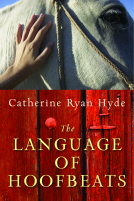Early after I got my Kindle I downloaded several books by Catherine Hyde Ryan. She has been a happy discovery and I have read five of her books in the last few years. Hyde's books always leaves one feeling elevated and optimistic about the human race. Her characters are flawed and damaged but grow into a more healthy version of themselves. Her publisher Lake Union Publishing pre-approved me to read any of their NetGalley offerings and it included The Language of Hoofbeats. They also published The Banks of Certain Rivers which I read and reviewed last month.
The Language of Hoofbeats is a well written book with great characters, socially relevant issues, and a realistic but sanguine outcome to the central crisis.
We encounter a Modern Family of the 21st century: two moms with an adopted son and two foster kids. The adopted eight year old son is a lovable and sweet child. Their foster son Mandy is aloof but no trouble. He misses his mom who is wrongfully imprisoned. The newest addition is Star, a difficult and unlikeable girl whose mother is mentally ill.
The family has moved and their new neighbor is a sixty year old woman who literally scares folk away she is that mean. He husband has left her after she could not tell him one thing that makes her happy. She can't bear to take care of her deceased daughter's horse, but also can't bear to lose the one thing her daughter loved.
Star secretly takes on the horse's care and under threat of separation the girl runs away with the horse. The two families are forced to work together creating a domino effect of changes in all their lives.
I enjoyed this book as much as the others I have read. Don't Let Me Go was about a little girl who enlists the help of her apartment neighbors, creating a surrogate family while her mother struggles with addiction. When You Were Older deals with racial profiling after 9-11. The main character narrowly missed dying in a Twin Tower office and has returned to his small home town. He meets an Egyptian woman whose father becomes a target of violence. Electric God is about a tormented man full of anger that dates back to the death of his brother. When I Found You concerns a man who finds a baby in the woods and wants to keep him. But the baby has a grandmother. Fifteen years later the grandmother returns the boy, now with a police record, to him.
The author is most well known for Pay It Forward upon which the movie starring Haley Joel Osment was based and became the motivation for the social movement and foundation of paying it forward.





































